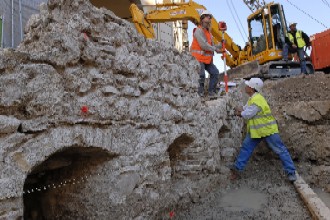“The population does not realize that Nice was a military town with ramparts and a stronghold.” These words are from Jacques Peyrat. They aim to legitimize the excavations carried out alongside the tramway construction. They reveal to the people of Nice their past, their history, their struggle. Journalists were invited to the archaeological research sites. Wearing fluorescent vests and helmets, they listened attentively to the speech by Marc Bouiron.
Two sites are brought to light along Boulevard Jean Jaurès, the former ramparts of Nice: the Old Bridge (Pont Saint-Antoine) and La Porte Pairolière. La Porte Pairolière played a strategic role. It defended the city. During the excavations covering 2000 m², archaeologists found traces of war, marks of cannonballs at the foot of the bastion. Constructed in the 14th century, it was located south of the current Place Garibaldi, which was established in 1782 (La Porte Pairolière was destroyed in 1706 by order of Louis XIV).
The Old Bridge was the only bridge that crossed the Paillon. It is situated at the level of the current street that bears its name. It had three arches. A few weeks ago, the teams from INRAP (National Institute of Preventive Archaeological Research) discovered an inscription that allowed them to date (1516) the foundation of the Paillon dam. The dig, reaching down to six meters in depth, is divided into two parts: one along Boulevard Jean Jaurès is covered and completed, and the other at the old staircase of Pont-Vieux Street, which connects the Old Nice with the boulevard, former bed of the Paillon. A part of the excavations and thus of the history of Nice will remain visible after completion of the tramway works.
The tram route crosses the historical heart of Nice. The relics of the past have thus appeared. Resurgences also such as the importance of the Paillon and the militarization of Nizza. It is also noted that the city, over time, has been raised. Archaeologists continue their work and go back in time. They will continue their work after the tramway is put into service under the concrete slabs. Historians will use it to study the history. Thus, the construction of the tramway, a symbol of modernism, has helped to revive Medieval Nice, which many Niçois were unaware of.




